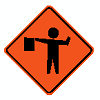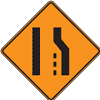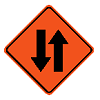Road work zones are necessary for the upkeep and improvement of Wisconsin’s infrastructure, and every year thousands of hard-working men and women participate in street, highway and bridge projects statewide. While all roadwork is temporary, the decisions – and mistakes – that drivers make in work zones can have a lasting impact.
There are unfortunately thousands of crashes in our work zones every construction season. Drivers and passengers – not workers – make up the vast majority of those either hurt or killed. It’s in every driver’s best interest to stay focused and patient – especially in work zones. Keep in mind that even at a reduced speed limit of 55 mph, a vehicle travels 80 feet per second and can clear a football field in the time it takes to glance at a phone or a radio dial. Combine the speed factor with narrow, shifting lanes and the chances of a crash can dramatically increase.
Any time people are working in a street or highway near traffic, drivers and workers are at risk:
- Major road construction
- Emergency vehicles at the side of the road
- A snowplow flashing its warning lights
- Everyday garbage pickup
In Wisconsin, they’re all work zones. Being able to identify the work zones up ahead can save lives. So, it’s best to learn the signs of a work zone.
Any combination of orange barrels, orange signs, flags, flagging operations, workers, or flashing lights may be involved. You might also see utility, maintenance or emergency vehicles. Surefire details include “work ahead” signs and, of course, workers.
Orange signs are used to communicate to drivers that they are entering, leaving or already in a work zone. Below are common examples of what you’ll see, so when you see any orange signs or barrels take extra caution. Workers are likely nearby.




In Wisconsin, we take work zone safety seriously. The penalties for careless driving are steep.
- It can cost you money. A normal speeding ticket can be expensive, but that’s nothing compared to traffic violations made in the zone. In a work zone, penalties are doubled – and fines usually increase every year.
- It can cost you time. The consequences for injuring or killing someone in a work zone are especially serious. Careless drivers may face thousands of dollars in fines and up to 31/2 years in prison if they injure someone in a work zone. The fines for vehicular manslaughter are even higher, as are the prison terms – as many as 10 years. These punishments may increase if the driver was intoxicated or a repeat offender.
- It can cost your life. The greatest cost of irresponsible driving isn’t calculated in dollars or years. Wisconsin sees nearly 2,000 work zone crashes a year. Sometimes, people die. And those tragedies change the lives of everyone left behind – workers, drivers and passengers, family and friends.
If you break down in a work zone
Whether it’s a blown tire or running out of gas, breakdowns are never a good thing. They can be especially challenging in road construction zones. It’s crucially important for motorists to be aware of their surroundings to stay safe. Wisconsin is one of many states that operates highway safety patrols for basic roadside service in some major work zones. This is done in the interest of keeping everyone safe by relocating disabled vehicles, brushing away debris and helping to manage traffic.

If you do break down in a work zone, it’s important to keep cool and follow these guidelines:
- Turn on your hazard lights. It’s important to warn other motorists of your presence.
- If you are OK and your vehicle is drivable, the Wisconsin Steer It, Clear It law requires you to move your vehicle to a safe location, away from traffic. Look for ramps or temporary pull-off zones.
- Dial 911 for assistance, especially if your vehicle is inoperable and blocking a lane of traffic, or if someone is hurt. However, keep in mind that Wisconsin’s highway safety patrols are often just moments away, so if help shows up before you can reach the phone, please refrain from dialing 911.
- Stay in your vehicle with your seat belt fastened. Your vehicle is typically the safest place to await roadside assistance. If you get out of your vehicle, you risk exposing yourself to potential work zone hazards such as unprotected drops, rough walking areas or construction equipment.
- Keep contact information for your insurance company or roadside assistance provider with you.
- Know where you are, especially if you do need to call for help. Being aware of mile markers or guide signs will make it much easier for someone to find you.
- Be prepared. It’s a good idea to keep a few items in your car to help in the event of a breakdown, including a visibility vest, a charged mobile phone, a first-aid kit, a warm blanket, extra clothing, water and snacks.
Drivers involved in a crash should do the following:
- Check for injuries. Call 911 if anyone is hurt. Provide accurate information about the location of the incident, severity of injuries, and number of lanes blocked.
- Stay safe and calm. Watch for traffic, stay inside the vehicle with a seat belt on while waiting for help.
- If you can steer it, clear it. Move out of traffic if the vehicle is not disabled.
- Turn hazard lights on or raise the hood of the vehicle to warn other drivers of the incident and avoid secondary crashes.
“Steer It, Clear It” became law in Wisconsin in 1998 and grants immunity from civil damages to anyone who clears the crash scene at the direction of law enforcement.
Drivers should also be aware of what to do when an emergency vehicle approaches on the roads. State law requires drivers to yield the right of way and pull over when an authorized emergency vehicle has its lights or sirens activated. Stay parallel to the right curb or right edge of the shoulder, clear of any intersection, until the emergency crews pass through the area.
Drivers are advised to “know before you go” by checking 511wi.gov before any road trip.

Learn more about safe driving in work zones.
- Did you know that tailgating is the most often cited factor in a work zone crash? Download WisDOT’s “Drive Like You Work Here” fact sheet.
- Safe driving is everyone’s responsibility
- Highway safety patrols
- Test your knowledge — take the work zone safety quiz!
Sources:
https://wisconsindot.gov/Pages/safety/education/workzone/default.aspx https://transportal.cee.wisc.edu/partners/community-maps/crash/search/BasicSearch.do
